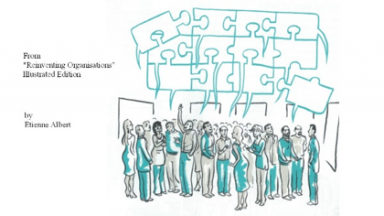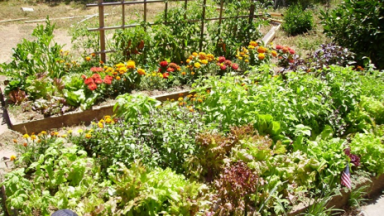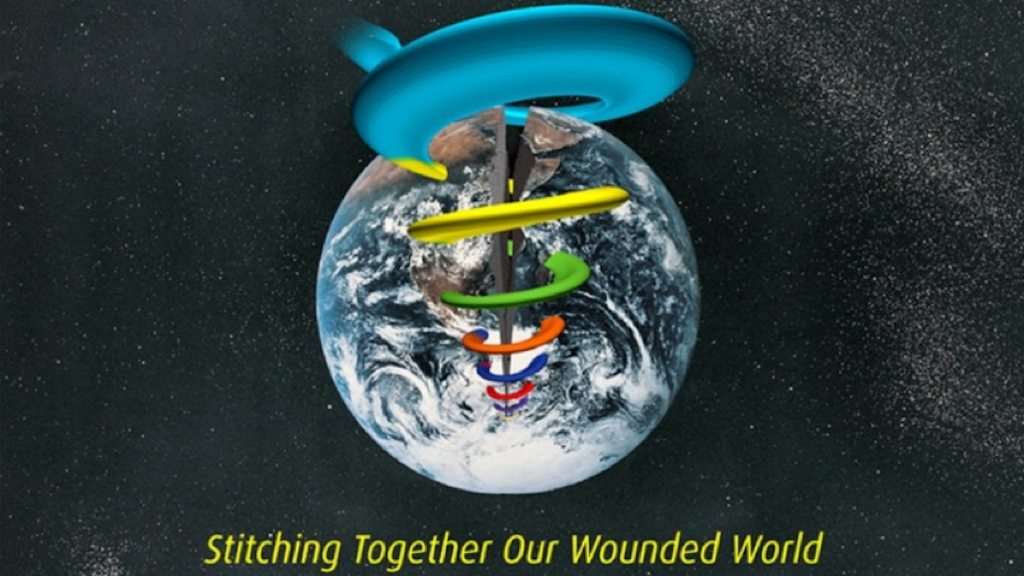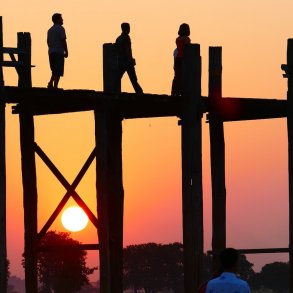By Jon Freeman for Enlivening Edge Magazine
In the first article of this series I described our existing money system, how it has arisen from earlier mind-sets to meet simpler world needs. The way we think—or thought—built our systems. I asked, “If our current systems were created from the mind-sets of earlier stages, what kind of system should we be creating now to reflect the new mind-set?” I asserted “The next stage demands a system which enables us to manage the complexity, open up the constraining circularity and unwind the history…. A comprehensive solution is possible. It means, in Integral terms, an all-quadrant, all-levels design”.
 Article 2 went further, discussing “capital” and broadening that word to mean more than money by extending it into social capital. environmental capital, as well as human and spiritual capital, as others have done. It looked at our internal drivers and spoke of the need to take back our power over money, to place it once again into the position of servant to humanity, not the master it has become. Money must represent and encompass all forms of capital.
Article 2 went further, discussing “capital” and broadening that word to mean more than money by extending it into social capital. environmental capital, as well as human and spiritual capital, as others have done. It looked at our internal drivers and spoke of the need to take back our power over money, to place it once again into the position of servant to humanity, not the master it has become. Money must represent and encompass all forms of capital.
By then a sense of direction was emerging. I built on that in the last article, Part 3, on our stewardship of the world. We know that wholeness is not present in the world of money. We know that the old system is breaking down, but not how to fix it. There is no collective agreement about how the world of money needs to work.
 Let me explain why this matters. I am not engaged in some dry or theoretical exercise. You might be familiar with the “heated frog” metaphor—that a frog in gradually warming water will fail to jump out, eventually boiling to death. Or you might know the image of how elephants can be trained—that a baby elephant tethered by a heavy chain will later as an adult be restrained by a thin rope. Both of these stories apply to our world, to us, with respect to how current money systems and attitudes are affecting our world gradually but increasingly negatively.
Let me explain why this matters. I am not engaged in some dry or theoretical exercise. You might be familiar with the “heated frog” metaphor—that a frog in gradually warming water will fail to jump out, eventually boiling to death. Or you might know the image of how elephants can be trained—that a baby elephant tethered by a heavy chain will later as an adult be restrained by a thin rope. Both of these stories apply to our world, to us, with respect to how current money systems and attitudes are affecting our world gradually but increasingly negatively.
So many of the major problems we face—inequality, climate change, resource issues, collapsing care and health systems—have a tendency to become intractable as soon as money issues are involved.
Money might not be the root of all evil, but in these contexts it becomes the water we cannot escape before we boil to death, or the rope around our ankle keeping us in a small circle. And like the warming water, we don’t question it. Humanity acts as if the money system is a given, the way things are, incapable of change.
There are alternatives on offer. Magnificent visions are offered by wise and brilliant people like Charles Eisenstein and Christian Felber. Initiatives based on commoning, disruptive start-ups, B Corporations, and alternative currencies are all entering the frame of society. Given enough time they could make a difference, just as the idea of “Green Energy” has, over the past two decades, spawned innovations and awakened energy-consciousness. Unfortunately, these alternative shifts are still on the margins of society, while the world as a whole plays leapless-frog with the literally-warming world. Governments and corporations, whether through well-intentioned stupidity or deeper malign intent, engage meanwhile in fracking the earth and genetically-engineering our agriculture, unable to see past the money to planetary reality.
How much time have we got?
This article is being written for a community of those who are croaking loudly and attempting to leap off the stove. I am not being critical; you are doing what you can, I have no doubt. If I ask “How much time have we got?” it is because I am worried. If I am suggesting that we are not yet doing enough, it is not to question anybody’s effort. It is to question whether there is something that we need to be doing to make those efforts more effective.
Quoting my earlier self again: “When not in fear, people act for the best and demonstrate their huge capacity for care and compassion. That demands the visible presence of an alternative to the fear; it requires creativity, leadership, and vision.” The fear in the world is palpable, and it is leading to increasing levels of irrational response. The fear of losing what we have is far greater than the fear of what has not yet occurred.
Our nervous systems, sensory apparatus, and limbic responses are in evolutionary terms older and more deeply embedded as behavioural drivers than our cognitive capacities to model and predict even the scariest of long-term scenarios. That often brings fight, flight, or freeze responses. Sometimes people grasp compulsively for a security blanket; even immediate risks are ignored. Passengers on the emergency-landed aircraft delay exit to grab possessions from the overhead lockers even as smoke fills the cabin.
There will be a tipping point in our chaotic conditions. I don’t know what it will be—economic collapse, a game-changing political event of 9/11 magnitude, or a climate event which brings that future into the present. I don’t know when it will happen, though I suspect sooner rather than later.
It might be that the only way for humanity is through the worst, experiencing catastrophic levels of devastation. That is, after all, our planetary history: of wars, famines, and collapsed civilisations. We are not immune to the fate of the Romans 2000 years ago, or the Chinese 1000 years later. Yet, we are in an unprecedented situation with opportunities our predecessors never had. We have already surpassed both of those civilizations in many ways. Our global pressures are matched by global connectivity. It is possible that we could make it go differently this time. I would like to try.
When the tipping point comes, it would make a difference if we could be prepared, if we could have potential solutions on the table. In the midst of the fear, when people would otherwise trample one another in their panic for the exits, what if we could have a plan? When the lights go out, what if there could be at least one candle left for us to follow?
Money systems are central to the shift we need.
Money systems are the treacle we wade through when addressing other problems. They are the bugs in the program, the faulty wiring that turns small problems into big ones and sabotages potentially self-balancing mechanisms. The old dogmas cannot work. As my friend and Conscious Capitalism UK colleague Gina Hayden shared with me yesterday as she prepares her forthcoming book, Becoming a Conscious Leader: How to Lead Successfully in a World that’s Waking Up, “Adam “Adam Smith could not have dreamed of nor comprehended the challenges faced by the average person today as they navigate their lives, let alone the challenges faced by leaders as they steer their companies through the choppy, complex and unpredictable seas of a globally-connected world. Even Milton Friedman, writing in 1970, would have had little idea of the unrecognisable context we live in in business today”.
The conclusion is inescapable. Alongside new mind-sets, we have to upgrade some of the mechanics of the existing system so that it supports them. We need to disable some of the recent changes to the system which have worsened its failings. We need to add new features to it which bring sustainability inside the money system. In some cases, the inadequacies of the system are used as a convenient excuse for those who choose to abdicate responsibility for their own warped choices, by claiming to be victims of the system. In many more cases we have all believed in our individual powerlessness and have accepted our victimhood.
The money system is not a fact of nature. It is a human construct so it can be reconstructed.
That is the task facing us. No one person is capable of encompassing that complexity. It will take a collective. It will take those on the enlivening edge, and will demand our exterior practicality, not just our enlightened interiors. What is needed is a project which leverages the wisdom of the collective and turns it into a system design for our future. I am inviting you to be part of its initiation.
 I believe that most of the necessary responses are already in existence. One metaphor for the project is that the pieces of the jigsaw puzzle are available, but we have no idea how to join them up. We don’t have the picture on the lid of the box to go by, and we need to create one.
I believe that most of the necessary responses are already in existence. One metaphor for the project is that the pieces of the jigsaw puzzle are available, but we have no idea how to join them up. We don’t have the picture on the lid of the box to go by, and we need to create one.
Another metaphor is that many of the pieces are visionary. In a loose sense we know the qualities that the new system requires. We have the values to aspire to. We know roughly where “there” is, but have little sense of how we could get there. We need a compass and some sense of what we will encounter on the way.
A precise plan is not possible. Changes will take place at every scale. Every country, culture, and company will have its own variations. Some aspects will call, ultimately, for global enablers. While global agreements are notoriously hard to achieve, they will be easier when the overall picture is visible, than they are now. We are setting the systemic criteria to shape the future.
Nor will this be an economic theory. Not monetarism, not communism, not keynesianism, and not even today’s capitalism. The future needs to jettison “-isms” because they are part of the problem. Arguing about which theories are right or wrong, and swinging between polarities, does not create responsiveness. In conditions of volatility and uncertainty and continual change, we must be agile and adaptable.
The new system design requires the integration of multiple balancing mechanisms. Contingent, continual choosing is a practice, not a theory. Accordingly, it also does not require consensus about “the right way”. Rather it requires alignment around the forces we have to integrate and the linkages which would need to be put in place. I can’t tell you what the output will look like; if I could there would be no need for the project. I can tell you how it will feel. It will feel like the picture of a world you would be excited and delighted to live in, and it will feel as if it puts a light at the end of the tunnel.
 There is no precedent for a project of this kind that I know of. I am inspired by the recent book Crowdocracy by Iman Stratenus and Alan Watkins, which has a foreword by Ken Wilber and an endorsement by Frederic Laloux, to believe that the concept is both timely and practical. There are suitable technical platforms available to offer a table to assemble the puzzle on.
There is no precedent for a project of this kind that I know of. I am inspired by the recent book Crowdocracy by Iman Stratenus and Alan Watkins, which has a foreword by Ken Wilber and an endorsement by Frederic Laloux, to believe that the concept is both timely and practical. There are suitable technical platforms available to offer a table to assemble the puzzle on.
What it takes is people. Initially, many people with knowledge about pieces of the puzzle who can work together to weave the threads. When the design is visible, it will need many more people to communicate, advocate, campaign, educate, and to develop implementation strategies, where they are and in whatever way they see as needed.
In case anyone worries about centralised control, that is not only undesirable; it would be quite unachievable. For those who believe that the new system has to be emergent, arising naturally and organically, I agree. This project cannot alter that requirement, but it can be a part of it happening. Gardens grow by themselves, but gardeners can help by preparing the soil, adding nutrients, and doing companion-planting.
The project needs people and that might be you. You might even be a contributor to the design. Or you might be the person who introduces someone else who would be enthused by this idea, or be someone who can support it in practical ways. Please share the vision. A fuller version of the proposal is available to view or download here. Please pass it on to others.
Credits: Thanks to Don Beck for the Wounded World image.

Jon Freeman is a strategic thinker and consultant specializing in systemic organizational redesign in support of conscious, values-led and purpose-driven culture change. He is also a Spiral Dynamics trainer and practitioner, and author of Reinventing Capitalism: How we broke money and how we fix it, from inside and out. Reach him at [email protected].





Hi Jon, I totally agree that re-inventing money is crucial to the needed transformation. I know that several movements work on this idea – ‘positive money’ being one of them. What is your take on these existing proposals and movements? Could the collaborative effort you are suggesting here be taking place with some of these existing movements as hosts or catalysts to gain quicker traction?
HI Bjorn. Thanks for your response, and apologies for not spotting it sooner.
The answer is yes. Positive Money is one piece of the jigsaw, and the idea of the collaboration is very much based on my belief that most or all of the pieces are already in existence. The challenge seems to be – so far – that most of the people who have a piece are focussed on that piece, and not thinking much about what else will need to happen around it. My view is that without the bigger picture, most of the pieces will struggle to penetrate and impact the system. In general they are getting picked off one by one, if they are noticed at all. I believe that until there is a larger, louder more coherent voice, nothing will change.